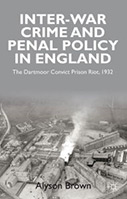Inter-War Penal Policy and Crime in England: The Dartmoor Convict Prison Riot, 1932

Author: Alyson Brown
Publisher: Houndsmills, Basingstoke, Hampshire; New York: Palgrave Macmillan, 2013. 208p.
Reviewer: Barry Godfrey| July 2015
Alyson Brown’s micro-history of the 1932 Dartmoor Prison riot uses a key event in penal history to focus our attention on interwar penal policy and practice. Brown demonstrates how this one key event can tell us much more about the penal estate and its aims and operations than a grand sweep covering the history of imprisonment. In her book, she advocates a micro-history which: ‘entails extensive examination and reconstruction of individual and family social relationships within a restricted geographical space and episodic which entails meticulous scrutiny of an event or encounter in order to illuminate aspects of a past society and culture that resist disclosure through more unconventional historical methods’ (Brown 2013,p. 133). I found her advocacy for micro-historical research methodology to be as interesting as the prison riot she analyses.
This persuasive argument comes late in the book, and possibly foregrounding this debate would have allowed both the reader to appreciate the approach more greatly, but also allow more ‘elbow room’ for debate. There is plenty more which could be said about the merits of micro-history, biographical history, narrative history, broad-brush history and so on, and Brown is very capable of providing balance to these kings of historiographical and methodological debate. However, her main focus is the riots which took place in Dartmoor prison on 24th January 1932.
On that day the simmering resentment against poor prison diet and alleged rough treatment against inmates reached mutinous levels. Fifty prisoners refused to obey orders when on parade, and when marched back to their cells, they refused to enter inside. The prison staff retired whilst the inmates smashed prison property and set free all the prisoners held in solitary confinement. The prisoners held sway for a couple of hours until the authorities arrived with armed reinforcements, and took back control of the prison. So, no lack of drama in this book, but it is not just a good yarn with some methodology tacked onto the end; it is a very detailed and meticulously-researched study which explores the prison conditions that created the disturbance, the event itself (and those who took part) and the subsequent official enquiry (the Du Parcq Report). The book would be interesting to historians of crime, naturally, but also to social historians, and those interested in the development of penal policy in the inter-war period. In terms of examining the factors which cause discontent amongst prisoners, the 1932 Dartmoor prison riot and its historians have much to offer contemporary researchers of prison life and penal policy. For me, the discussion about the utilities of micro-history will be the part of the book that is of greatest interest to history students. For that reason I would encourage social historians of all types, not just those interested in crime or prisons, to pick this book from the shelves, and place it on their book lists.
Professor Barry Godfrey, Sociology, Social Policy and Criminology – Liverpool University


